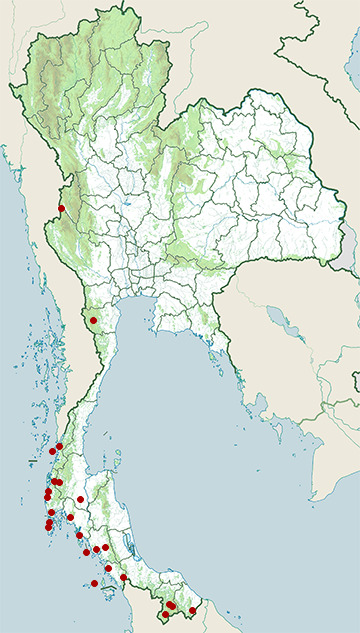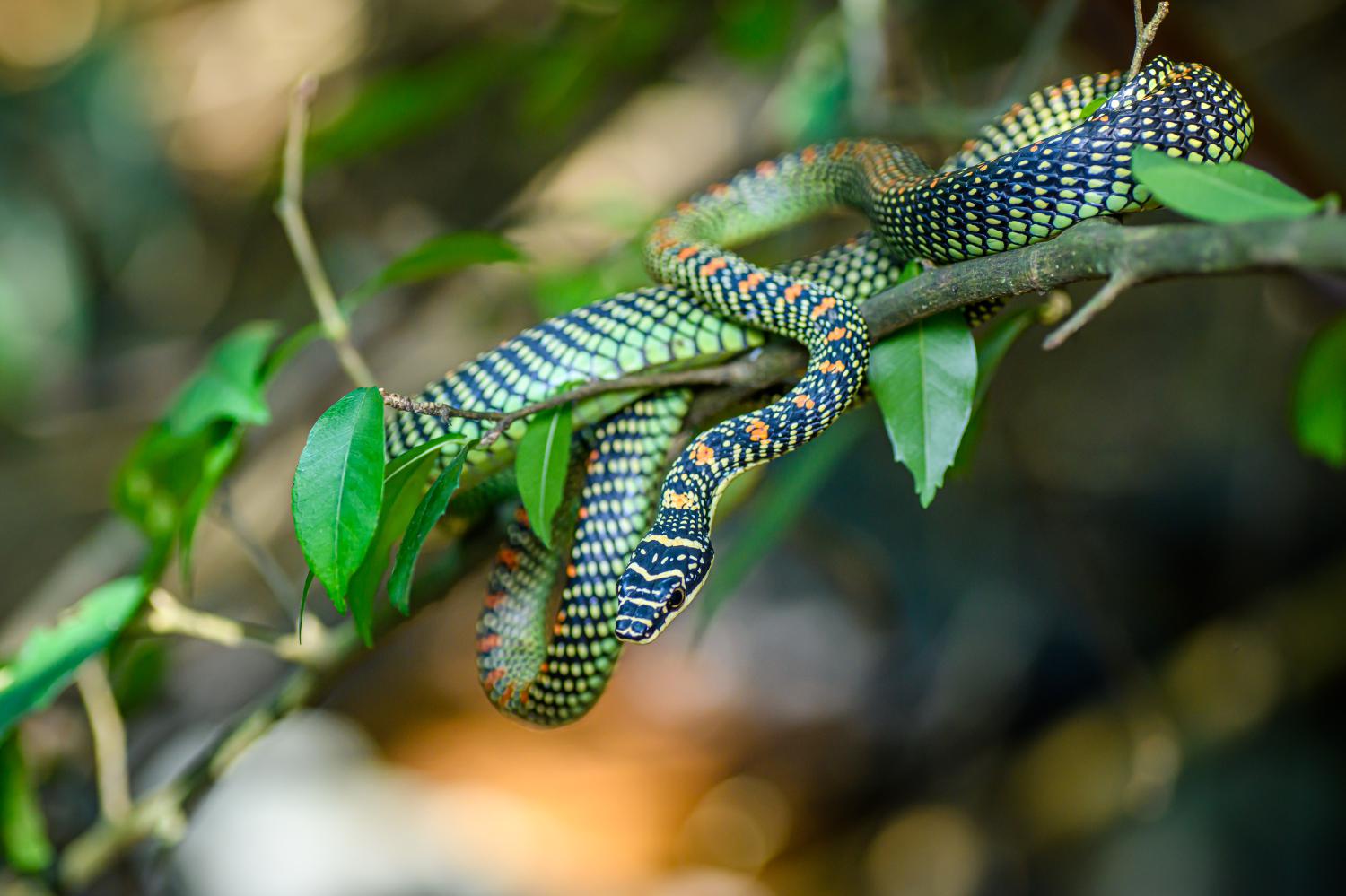Species of Thailand
Paradise tree snake
Chrysopelea paradisi
Heinrich Boie, 1827
In Thai: งูเขียวร่อน, ngu khieow ron
Paradise tree snake or paradise flying snake (Chrysopelea paradisi) is a species of snake found in southeastern Asia. It can, like all species of its genus Chrysopelea, glide by stretching the body into a flattened strip using its ribs. It is mostly found in moist forests and can cover a horizontal distance of 10 meters or more in a glide from the top of a tree. Slow motion photography shows an undulation of the snake's body in flight while the head remains relatively stable, suggesting controlled flight. They are mildly venomous with rear fangs and also can constrict their prey, which consists of mostly lizards and bats.
Researchers in 2014 conducted a study by manipulating airflow and conducting detailed morphological analyses on the species. As they did so, they unveiled the relationship between the snake's unique body shape and its gliding performance. Their bodies being much flatter and elongated as well as them being much more flexible in their structure. This research helped a lot not just in the biological field but by drawing inspiration from Chrysopelea paradisi’s body shapes and the way they function, researchers aim to develop flying machines that are efficient and energy saving. Thus, the study of this species not only enriches our understanding of vertebrate flight but also catalyzes advancements in engineering disciplines, propelling us towards new frontiers in biomimicry and aerospace technology.
Kinematics
The flying snake has a unique kinematic that is different compared to other animals with gliding or flight because they are cylindrical and do not have limbs such as legs or wings. Although the flying snake does not display visible characteristics that contribute to its ability to glide, there are three aspects that have been studied and found to have great positive effects on this. Their form of takeoff which is most commonly the anchored J-loop take-off, once airborne their cross sectional body is shaped into a triangle and their bodies use an aerial undulation to maximize the distance traveled.
Distribution
Thailand (incl. Phuket), Cambodia, Indonesia (Bangka, Belitung, Java, Mentawai Archipelago, Natuna Archipelago, Nias, Riau Archipelago, Sumatra, We, Borneo, Sulawesi), Brunei Darussalam; India (Andaman Islands), Malaysia (Malaya and East Malaysia); Myanmar (Burma); Philippine Islands (including Sulu Archipelago, Negros Oriental, Siquijor, Panay, Luzon); Singapore; Race celebensis: Indonesia (Sulawesi) ; Bangladesh (Sylhet, Chittagong, Khulna, Race: Golden Flying Snake).
Race variabilis: Philippine Islands (including Sulu Archipelago)
This article uses material from Wikipedia released under the Creative Commons Attribution-Share-Alike Licence 3.0. Eventual photos shown in this page may or may not be from Wikipedia, please see the license details for photos in photo by-lines.
Scientific classification
- Kingdom
- Animalia
- Phylum
- Chordata
- Class
- Reptilia
- Order
- Squamata
- Suborder
- Serpentes
- Family
- Colubridae
- Genus
- Chrysopelea
- Species
- Chrysopelea paradisi
Common names
- German: Paradies-Schmuckbaumnatter
- English:
- Paradise tree snake
- Paradise flying snake
- Thai:
- งูเขียวร่อน, ngu khieow ron
- งูเขียวดอกหมาก, ngu khiao dokmak
Subspecies
Chrysopelea paradisi celebensis, Robert Mertens, 1968
Range: Indonesia (Sulawesi)
Chrysopelea paradisi paradisi, Friedrich Boie, 1827
Range: Thailand, Indonesia, Brunei Darussalam, India (Andaman Islands), Malaysia (Malaya and East Malaysia, Pulau Pangkor), Myanmar, Philippine Islands, Singapore
Chrysopelea paradisi variabilis, Robert Mertens, 1968
Range: Philippine Islands (including Sulu Archipelago, Panay)
Conservation status

Least Concern (IUCN3.1)
Photos
Please help us review our species pages if wrong photos are used or any other details in the page is wrong. We can be reached via our contact us page.
Range Map

- Bang Lang National Park
- Betong District, Yala
- Kaeng Krachan National Park
- Kantang District, Trang
- Kathu District, Phuket
- Khao Lak - Lam Ru National Park
- Khao Sok National Park
- Ko Kradan
- Ko Lanta District, Krabi
- Ko Phayam
- La-ngu District, Satun
- Mu Ko Ranong National Park
- Mueang Krabi District, Krabi
- Phrasaeng District, Surat Thani
- Sri Phang-nga National Park
- Takua Pa District, Phang Nga
- Takua Thung District, Phang Nga
- Tarutao National Marine Park
- Thalang District, Phuket
- Thale Ban National Park
- Than To District, Yala
- Thung Yai Naresuan Wildlife Sanctuary
- Waeng District, Narathiwat
- Yan Ta Khao District, Trang

